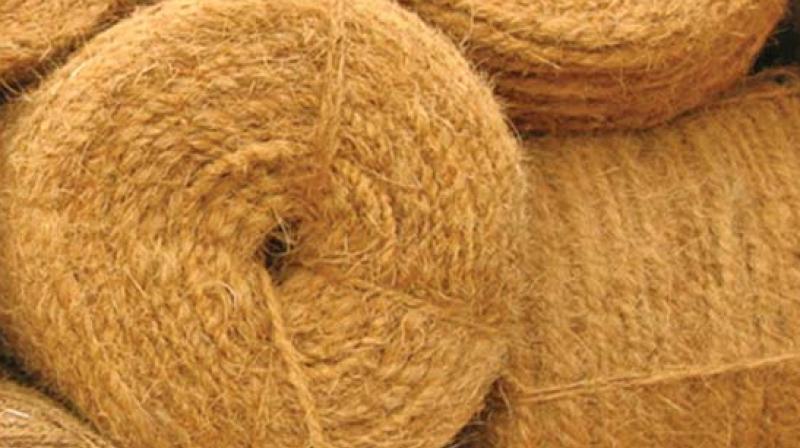Coir Board has set up outlets for popularizing the coir products 29/11/2019 – Posted in: Press Information Bureau – Tags: Coir Board of India, scheme of fund for regeneration of traditional industries (sfurti)
Coir Products
Ministry of Micro, Small & Medium Enterprises
WHAT
Government of India through Coir Board has set up 30 outlets throughout the Country for popularizing and selling coir products.
The Coir Industry in India is an export-oriented industry.
COIR, COIR PRODUCTS & THEIR ADVANTAGES
- Coir, or coconut fibre, is a natural fibre extracted from the husk of coconut and used in products such as floor mats, doormats, brushes and mattresses. Coir is the fibrous material found between the hard, internal shell and the outer coat of a coconut.
- Brown coir (made from ripe coconut) are used in upholstery padding, sacking and horticulture.
- White coir, harvested from unripe coconuts, is used for making finer brushes, string, rope and fishing nets.
- Red coir is used in floor mats and doormats, brushes, mattresses, floor tiles and sacking.
- In agriculture and horticulture, coir is a substitute for sphagnum (peat moss) and peat because it is widely available and environmentally friendly.
- Coir has the advantage of not sinking, so can be used in long lengths on deep water without the added weight dragging down boats and buoys.
STEPS TAKEN TO POPULARIZE COIR PRODUCTS
- Government has opened showrooms throughout the country.
- BIS standards have been got approved for coir geo-textiles.
- Coir Board initiated action to join hands with KVIC for marketing coir products through KVIC Showrooms.
- Regular publicity of various coir products.
- 41 numbers of SFURTI coir clusters have been approved and 16 coir clusters are functional.
- To modernize the coir industry, youngsters and women artisans are being trained. In the last three years, 6474 number of women artisans have been trained.
- Coir Board organizes participation in important national and international exhibitions.
COIR BOARD OF INDIA
- The Coir Board is a statutory body. The board functions under the Ministry of Micro, Small and Medium Enterprises.
- It was established by the Government of India under the Coir Industry Act 1953 for the promotion and development of the coir (coconut fibre) industry in India.
- It is based in Kochi and Alappuzha. The head office of the Coir Board is in Kochi and the research and training office is in Kalavoor, Alappuzha.
SCHEME OF FUND FOR REGENERATION OF TRADITIONAL INDUSTRIES (SFURTI)
- Ministry of MSME has launched this scheme in the year 2005 with the view to make the traditional industries more competitive, market-driven, productive, profitable and capable of providing sustainable employment for traditional industry artisans and rural entrepreneurs.
- The Coir Board is the Nodal Agency for the implementation of the scheme.
- The scheme envisages for setting up of Common Facility Centres, Capacity building measures, Product development and design intervention centres and Market promotion assistance including setting up of outlets in the selected coir clusters.
Objectives of the scheme
- Develop clusters of traditional industries in India.
- Make traditional industries more competitive with more market-driven, productive, profitable and creation of sustainable employment for rural folk.
- Strengthen local governance, active participation of the local stakeholders for developmental initiatives.
- Build up innovative and traditional skills, improved technologies, advanced process, market intelligence etc., for the regeneration of traditional industries.
Important Information
- India, mainly in Pollachi and the coastal region of Kerala State, produces 60% of the total world supply of white coir fibre.
- Sri Lanka remains the world’s largest exporter of coir fibre and coir fibre based products.
- The name coir comes from kayar, a Dravidian word for cord, used Tamil, with neither language clearly proven to be the origin.
- Bristle coir is the longest variety of coir fibre. It is manufactured from retted coconut husks through a process called defibring.
- Mature brown coir fibres contain more lignin and less cellulose than fibres such as flax and cotton, so are stronger but less flexible.
- Coir is also used as a substrate to grow mushrooms.
- Due to its superior absorption capabilities when compared to products made of clay, silica and diatomaceous earth-based absorbents, dry coconut coir pith is gaining popularity as an oil and fluid absorbent.
Source: PIB
READ MORE PIB UPDATES
- 1st International Conference on “Landslides Risk Reduction and Resilience-2019″
- YuWaah India
- The Insolvency and Bankruptcy Board of India
- Global Bio-India Summit, 2019
- NSS report no. 583: Persons with Disabilities in India
- NSS report no.584: Drinking-Water, Sanitation, Hygiene and Housing condition in India
- Council of Heads of Government (Prime Ministers) of SCO Member States
- Patent Prosecution Highway programme
- Credit Guarantee Fund Scheme
You are on the Best Online IAS preparation platform. You are learning under experts.
We are present on Facebook- Diligent IAS, LinkedIn- Diligent IAS, YouTube- Diligent IAS, Instagram- Diligent IAS. Get in touch with us.

